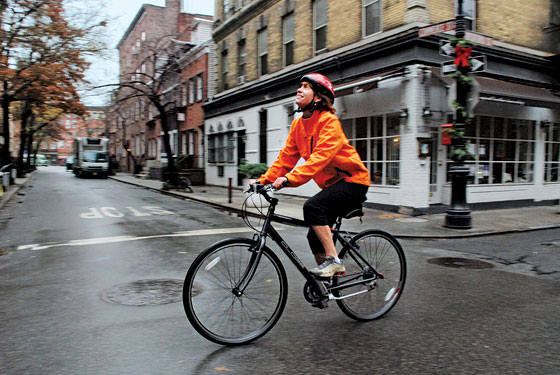
Nobody in New York City controls as much public space as the Department of Transportation, and for the first five and a half years of the Bloomberg administration, the DOT was what it has always been—a large, dull bureaucracy dedicated to moving cars and trucks around town. Run mostly by engineers, the DOT treated streets as an engineering problem: How do you move as many motor vehicles as possible, as quickly as possible? The streets themselves have mostly remained grim, unattractive, and (ironically) jammed.
But recently, the DOT has been championing some very un-DOT ideas. It has replaced parking lots and traffic lanes with chairs and umbrellas in Dumbo and the meatpacking district and installed a new, physically separated bike lane on Ninth Avenue; it is pushing the mayor’s controversial congestion- pricing plan; and, in a symbolic act, it has given over three parking spots by the Bedford Avenue L stop to bike racks. Taken together, it’s as if the department has awakened to the idea that streets belong to people, not their vehicles.
The difference can be summed up in one name: Janette Sadik-Khan. When Mayor Bloomberg tapped her in April to become the new DOT commissioner, Sadik-Khan may have appeared, on paper, a conservative choice. For nearly two decades, she had run transportation projects under Mayor Dinkins, the U.S. Department of Transportation, and planning and engineering giant Parsons Brinckerhoff. But this experience belies a transportation philosophy that is, by DOT standards, radical—something she proved when she promptly hired three of DOT’s fiercest critics. Since then, like a communist chairing the Federal Reserve Board, she’s turned the creaking department on its head.
According to Sadik-Khan, New York streets should be brimming with activity, not cars. She wants to see broad sidewalks filled with people and elegant street furniture, public plazas with places to sit and chat, and bike lanes where children feel safe on their bikes. “Whether you’re cycling and you lock up to a fanciful bike rack,” she says, “or you’re a pedestrian and you come across a fabulous open space that makes you want to linger—that, I think, defines the quality of life in cities.”
Getting there means “we’re going to have to do some things a little differently,” she warns. “We’re going to have to get people out of their cars.” To that end, Sadik-Khan is rolling out pilot programs as fast as she can—new public plazas, wider sidewalks, a bike-rack design competition. Her mission, fundamentally, is to remake the real estate between buildings by, as she puts it, “reclaiming the street from cars.” In traffic-management circles, such a statement is practically heresy.
Sadik-Khan has a lot of work to do before the Bloomberg clock runs out, but her programs are already shaking up the once-fusty DOT. Momentum will only increase as she rolls out new Greenmarkets in ferry terminals and plazas in the Bronx. “Two and a half years is an incredible motivator,” she says. “There’s no time to waste.”